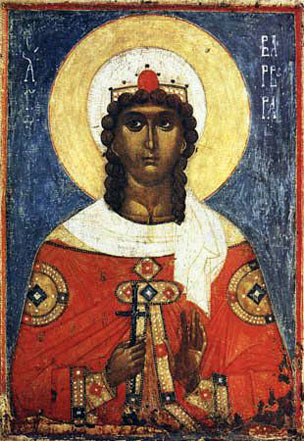
The Holy GreatMartyress Barbara
Commemorated on December 4
The Holy GreatMartyress Barbara lived and suffered during the reign of the emperor Maximian (305-311). Her father, the pagan Dioskoros, was a rich and illustrious man in the city of Phoenician Heliopolis; early left a widower, he concentrated all his attention in tender devotion to his only daughter. Seeing the extraordinary beauty of Barbara, Dioskoros decided to raise her concealed from the eyes of strangers. For this he built a tower, where besides Barbara, there were present only her pagan teachers. From the tower heights there opened up a view of God's world of hills stretching into the distance. By day she was able to gaze upon the wooded hills, the swiftly flowing rivers, and on the meadows covered with a gayly mottled blanket of flowers; by night the harmonious and majestic vault of the heavens twinkled and provided a spectacle of inexpressible beauty. Soon the maiden began to ask herself questions about the Primal Cause and Creator of so harmonious and splendid a world. Gradually she became convinced of the idea, that the soul-less idols – were but only the work of human hands, and though her father and teachers offered them worship, the idols were not sufficiently clever and august enough to have made the surrounding world. The desire to know the True God so consumed the soul of Barbara, that she decided to devote all her life to this and to spend her life in virginity.

But the fame of her
beauty spread throughout the city, and many sought for her hand in marriage.
But despite the endearing entreaties of her father, she refused. Barbara
cautioned her father, that his persistence might end tragically and separate
them forever. Dioskoros decided, that the temperament of his daughter had been
affected by her life of seclusion. He therefore permitted her to leave the
tower and gave her full freedom in her choice of friends and acquaintances. The
maiden thus encountered in the city youthful confessors of faith in Christ, and
they revealed to her teachings about the Creator of the world, about the
Trinity, and about the Divine Logos. Through the Providence of God, after a
certain while there arrived in Heliopolis from Alexandria a priest in the guide
of a merchant. He performed the sacrament of Baptism over Barbara.
During this while at
the house of Dioskoros a luxuriant bath was being built. By his orders the
workers prepared to put into it two windows on the south side. But Barbara,
availing herself of her father's absence, asked them to make a third window, in
the form of a Trinity of Light. Over the entrance of the bath-house Barbara
patterned a cross, which was durably set into stone. On the stone steps of the
bath-house there later remained the imprint of her feet, while within the
water-spring had dried up, appearing later on with great healing power, – all
which Simeon Metaphrastes in writing about the sufferings of the holy
martyress, compares with the life-creating power of the stream of Jordan and
the Pool of Siloam. When Dioskoros returned and expressed dissatisfaction about
the change of his plan of construction, his daughter told him about her
knowledge of the Triune God, about the saving power of the Son of God, and
about the futility of worshipping idols. Dioskoros went into a rage, grabbed a
sword and was on the point of striking her. The maiden fled from her father,
and he rushed after her in pursuit. His way became blocked by an hill, which
opened and concealed the saint in a crevice. On the other side of the crevice
was an entrance upwards. Saint Barbara managed then to conceal herself in a
cave on the opposite slope of the hill. After a long and fruitless search for
his daughter, Dioskoros saw two shepherds on the hill. One of them pointed out
the cave to him, where the saint had hidden. Dioskoros beat his daughter
terribly, and then locked her under watch and tried to wear her down with
hunger. Finally he handed her over to the governor of the city, named
Martianus. They beat Saint Barbara fiercely: they struck at her with ox thongs,
and ground into her wounds with an hair-shirt. By night the holy maiden prayed
fervently to her Heavenly Bridegroom, and the Saviour Himself appeared and
healed her wounds. Then they subjected the saint to new, and even more cruel
torments.
Amidst the crowd
standing near the place of torture of the martyress was the Christian Juliania,
an inhabitant of Heliopolis. Her heart was filled with sympathy for the
voluntary martyrdom of the beautiful and illustrious maiden. Juliania likewise
wanted to suffer for Christ. She began loudly to denounce the torturers, and
they seized hold of her. For a long while they tortured both holy martyresses:
they lacerated and tore at their bodies with hooks and then led them stripped
through the city amidst derision and jeers. Through the prayers of Saint
Barbara the Lord sent an Angel, which covered the bareness of the holy
martyresses with splendid garb. The steadfast confessors of faith in Christ,
Saints Barbara and Juliania, were then beheaded. Dioskoros himself executed
Saint Barbara. The wrath of God was not slow to punish both torturers,
Martianus and Dioskoros: they were struck down by bolts of lightning.
In the VI Century the
relics of the holy GreatMartyress Barbara were transferred to Constantinople.
In the XII Century the daughter of the Byzantine emperor Alexis Comnenes, the
princess Barbara, having entered into marriage with the Russian prince Mikhail
Izyaslavich, transferred them to Kiev. They rest even now at the Kiev Vladimir
cathedral.
© 1996-2001 by translator Fr. S. Janos.